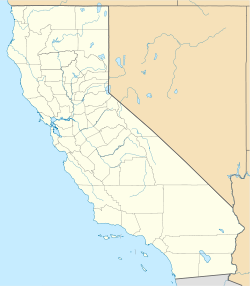El Cabrillo
|
El Cabrillo
|
|
 |
|
| Location | 1832-1850 N. Grace Ave., Hollywood, Los Angeles, California |
|---|---|
| Coordinates | 34°6′18.3″N 118°19′54.7″W / 34.105083°N 118.331861°WCoordinates: 34°6′18.3″N 118°19′54.7″W / 34.105083°N 118.331861°W |
| Built | 1928 |
| Architect | Arthur and Nina Zwebell |
| Architectural style | Spanish Colonial Revival |
| NRHP Reference # | |
| LAHCM # | 773 |
| Significant dates | |
| Added to NRHP | March 30, 2005 |
| Designated LAHCM | December 16, 2003 |
El Cabrillo is a two-story, ten-unit Spanish-style courtyard condominium building located at the southeast corner of Franklin Avenue and Grace Avenue in Hollywood, Los Angeles, California. The Spanish Colonial Revival style building was designed by noted architects Arthur and Nina Zwebell and built in 1928 by movie mogul Cecil B. DeMille. El Cabrillo is the only building designed by the Zwebells using brick, a superior construction material as compared to their other courtyard buildings constructed using stucco and wood. It became one of the most fashionable addresses in Hollywood in the late 1920s and 1930s and was more recently used as the home of the main character in the television series Chuck. It has been designated as a Los Angeles Historic-Cultural Monument and listed in the National Register of Historic Places.
El Cabrillo has a long association with the movie business. In 2007, The Hollywood Reporter described El Cabrillo as a building "steeped in old Hollywood lore," and in 2004, The New York Times called El Cabrillo "a two-story complex that has more fabled than factual stories attached to it, the mark of a true Hollywood star."
The building was built by Cecil B. DeMille in 1928. David Wallace, the author of Lost Hollywood (St. Martin's Press, 2001), believes DeMille built El Cabrillo to house New York stage actors whom he brought to Los Angeles when talking pictures arrived. Others claim that DeMille intended it as a gift for his daughter Frances. Whichever version is correct, DeMille was responsible for a building that became one of the most fashionable addresses in Hollywood. The building's notable features include its Spanish-style courtyard and fountain, hand-made tiles, large fireplaces, and high-beamed ceilings. According to The New York Times, DeMille used set craftsmen to construct "the phantasmagorial sense of architectural detail at El Cabrillo, which includes a central outdoor Moorish fountain, timbered ceilings, Catalina tile work, swashbuckling wrought-iron hardware and scaled-down versions of Citizen Kane-like carved concrete fireplaces in each apartment." David Wallace, who once managed the property, said: "It's like walking into a movie."
...
Wikipedia



